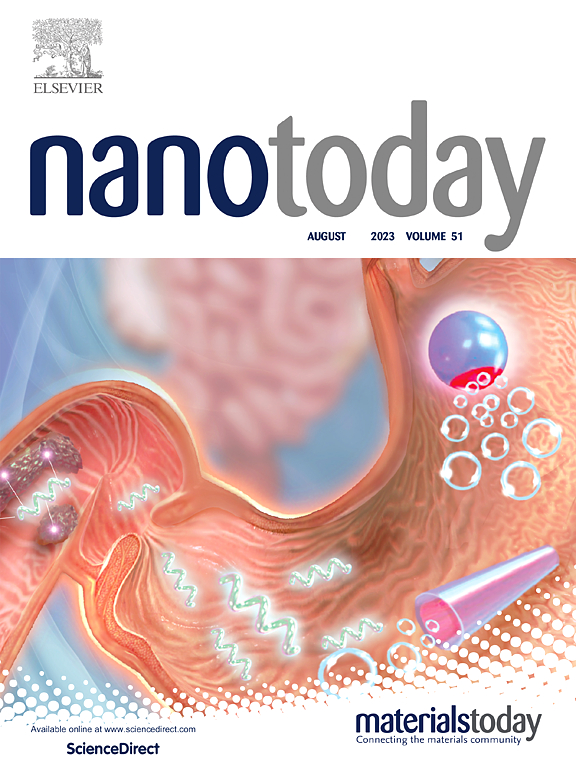自供电Pt/ZnO肖特基器件中形貌驱动的紫外光探测
IF 13.2
1区 材料科学
Q1 CHEMISTRY, MULTIDISCIPLINARY
引用次数: 0
摘要
新兴的纳米结构材料为高性能光电器件的设计,尤其是自供电光电探测应用开辟了新的领域。在这里,我们展示了新型 Pt/ZnO 肖特基势垒器件的自供电紫外光检测能力,该器件采用两种不同的 ZnO 形态制造:树枝状纳米团簇(DNC)和纳米微团簇阵列(NMCAs)。这两种结构都显示出强大的自供电紫外光检测性能,尽管它们的光电行为存在显著差异。基于 DNC 的紫外光光电探测器(Pt/ZnODNCs)的特点是纳米粒子间的连接较弱,结构尺寸较小,在高强度紫外光照射下表现出光电流降低、噪声水平升高和非线性光响应动态。相反,基于 NMCA 的器件(Pt/ZnONMCAs)是通过使用单个乙醇液滴进行毛细管驱动的 DNC 自组装形成的,其性能显著提高,光电流增加了近千倍,同时还具有出色的可重复性和长期稳定性。此外,Pt/ZnONMCAs 的响应时间提高了 3.5 倍,在自供电模式下,紫外光强度为 2.5 mW-cm-²,上升时间为 9.6 秒,而基于 DNC 的变体为 51.9 秒。这些发现强调了 NMCA 结构氧化锌纳米材料作为光电导器件高性能候选材料的巨大潜力,推动了自供电光电技术的发展。本文章由计算机程序翻译,如有差异,请以英文原文为准。
Morphology-driven UV photodetection in self-powered Pt/ZnO Schottky devices
Emerging nanostructured materials have opened new frontiers in the design of high-performance optoelectronic devices, particularly for self-powered photodetection applications. Here, we present the novel self-powered UV photodetection capabilities of Pt/ZnO Schottky barrier devices that fabricated with two distinct ZnO morphologies: dendrite-like nanoclusters (DNCs) and nano- micro-cluster arrays (NMCAs). Both architectures demonstrate robust self-powered UV photodetection performance, albeit with significant differences in their optoelectronic behavior. The DNC-based UV photodetector (Pt/ZnODNCs), characterized by weak inter-nanoparticle connections and smaller structural dimensions, exhibits reduced photocurrent, higher noise levels, and non-linear photoresponse dynamics under elevated UV illumination. Conversely, the NMCA-based devices (Pt/ZnONMCAs), formed through capillary-driven self-assembly of DNCs using a single ethanol droplet, achieve a dramatic enhancement in performance, with a nearly thousand-fold increase in photocurrent, alongside excellent repeatability and long-term stability. Furthermore, the Pt/ZnONMCAs exhibit a 3.5-fold improvement in response time, with a rise time of 9.6 s compared to 51.9 s for the DNC-based variant under a UV light intensity of 2.5 mW·cm-² in self-powered mode. These findings underscore the significant potential of NMCA-structured ZnO nanomaterials as high-performance candidates for photoconductive devices, advancing the development of self-powered optoelectronic technologies.
求助全文
通过发布文献求助,成功后即可免费获取论文全文。
去求助
来源期刊

Nano Today
工程技术-材料科学:综合
CiteScore
21.50
自引率
3.40%
发文量
305
审稿时长
40 days
期刊介绍:
Nano Today is a journal dedicated to publishing influential and innovative work in the field of nanoscience and technology. It covers a wide range of subject areas including biomaterials, materials chemistry, materials science, chemistry, bioengineering, biochemistry, genetics and molecular biology, engineering, and nanotechnology. The journal considers articles that inform readers about the latest research, breakthroughs, and topical issues in these fields. It provides comprehensive coverage through a mixture of peer-reviewed articles, research news, and information on key developments. Nano Today is abstracted and indexed in Science Citation Index, Ei Compendex, Embase, Scopus, and INSPEC.
 求助内容:
求助内容: 应助结果提醒方式:
应助结果提醒方式:


